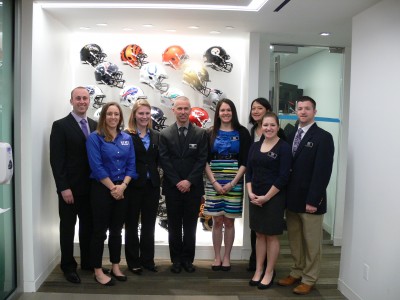
By Alicia Pike, Assistant Director of Youth Sport Safety
On March 26th and 27th, the National Athletic Trainers’ Association (NATA) and American Medical Society for Sports Medicine (AMSSM) in conjunction with the Korey Stringer Institute (KSI) and the National Football League (NFL) hosted the very first “Collaborative Solutions for Safety in Sport” meeting at the NFL Headquarters in New York, NY. This meeting was made possible by the lead sponsors, NATA and AMSSM. Corporate sponsorship was provided by MISSION Athletecare, Jones & Bartlett Learning, PRIVIT, and Camelback, and supported by KSI and NFL organizations.
We know from years of research that many of the deaths that occur in sport are preventable if best practices for prevention and management are in place. Therefore, the goal of this meeting was to bring together the state high school association leaders and sports medicine advisory committee members and the National Federation of State High School Associations to discuss development and implementation of best practice policies for safety in sport. We are excited to have had representation from all 50 states in one room for this meeting, and provided opportunities for key decision-makers to review and enhance safety policies currently in place in their respective states to reduce risk of sudden death in high school sports.
Chris Valletta, co-founder of MISSION Athletecare kicked off the meeting with the keynote. The remainder of this first day involved emphasis on best practices and policy implementation for heat-related illness and cardiac events. Dr. Douglas Casa, Chief Operating Officer of KSI, spoke about the importance of policies including heat acclimatization and wet-bulb globe temperature monitoring that should be in place at every high school, as well as proper recognition (via a rectal thermometer) and treatment (ice water immersion bath) of heat-related illnesses. Regarding cardiac events, Dr. Jonathan Drezner, team physician for the University of Washington and Seattle Seahawks, spoke about the absolute necessity of having AED’s readily available at all high schools and competition/practice locations, as well as the importance of regularly practicing emergency action plans and performing monthly checks of AED batteries and pads to ensure they are ready to use in case of an emergency cardiac situation.
The second day began with a keynote address from Dr. Brian Hainline, Chief Medical Officer of the NCAA. Following his speech, Ron Courson, Athletic Director of Sports Medicine at the University of Georgia spoke about emergency action plans and when properly implemented, practiced, and executed, can ultimately save the life of an athlete. To close out the meeting, Dr. Kevin Guskiewicz, Director of the Matthew Gfeller Sport-Related Traumatic Brain Injury Research Center in UNC Chapel Hill, spoke about head injuries, including concussions, and the policies that should be in place at every school to protect the health and safety of the student-athletes. Guskiewicz brought home the idea that “This is not an injury that can be managed by a clock, calendar, or cookbook.” Head injuries should be treated on an individual basis, and policies need to be implemented to ensure the athlete is not returning to sport before he/she is physically and cognitively ready.
The meeting was an absolute success for being the first time in history that the key people from each state were together in one room for the same initiative. Great questions, comments, success stories, as well as struggles were brought up from those in attendance. We each face challenges regarding policy development and implementation, but this could be achieved more quickly if we collaborate and work together. With this meeting, the NATA, AMSSM, KSI, and NFL hope to have instilled in the attendees the knowledge and materials the attendees need to return to their respective states and make change happen; change that will follow best practices, change that will ensure athletes are getting the absolute best medical care they deserve, and change that can save a life. “A 2 millimeter difference can make a mile change.” Are you prepared? Do more than care. Think. Act. Make a change. Save a life.
For more resources and information that were shared at the meeting, please visit: www.SolutionsForAthleteCare.org.
